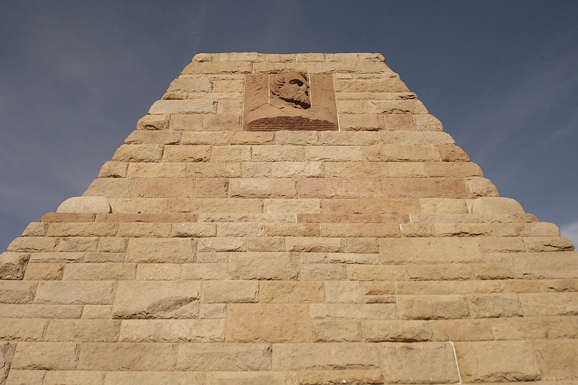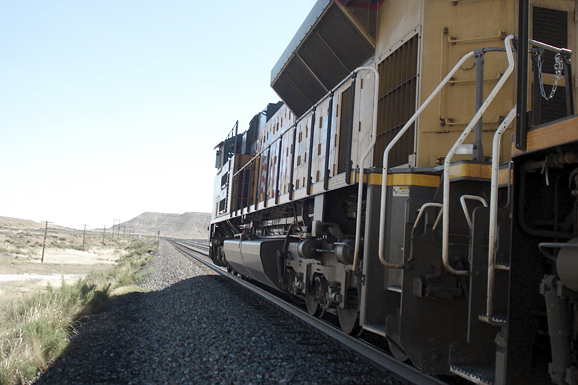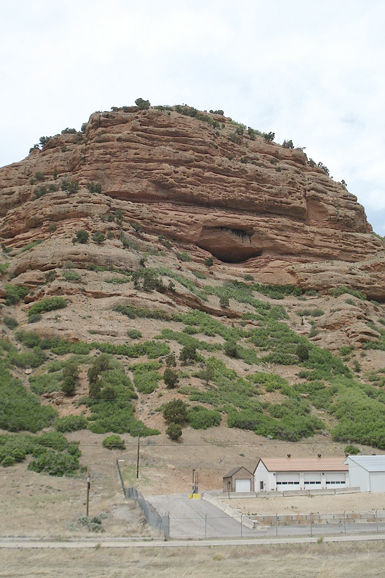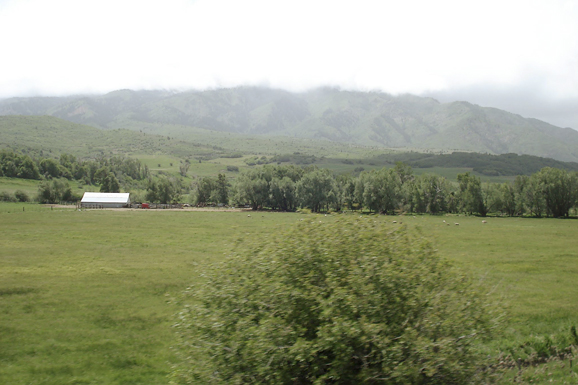West Coast freight-jumping beats the East Coast (Cheyenne to Ogden)
It had been six years since my last long Western ride. Back in 2006, I’d ridden Elko-Salt Lake City and Ogden-Elko, first along the southern shore of the Great Salt Lake and then back to Elko on the freight-only route with the 12-mile-long causeway across the shimmering, pungent lake.
Since 2007, I had aged or, more accurately, rotted in a part of the country where I moved solely to work, with only two un-disastrous but less than transformational journeys to Harrisburg, Pa., and Brunswick, Md., to tide me over.
This time, after cobbling together the vacation time, I was headed west from Cheyenne: either 484 miles to Ogden or 552 miles to Pocatello. I was hoping for Pocatello, having heard that going there was more scenic. The westbound Union Pacific line forks in Granger, Wyo., 30 miles west of Green River. Both Cheyenne and Pocatello had Amtrak service but lost it years ago.
I’d handed in my rental car after heading 30 miles out of town that morning to check out a 19th century monument, a pyramid dedicated to the railroad-building Ames brothers.

The rental car outfit gave me a lift downtown, where I stopped being a gawking tourist and reverted to type. I’d been in town two days and drew comfort from the sight of men with frame packs. I knew what they were.
After comparing the east and west ends of the yard, I’d chosen the east. The Cheyenne yard has a menacing control tower with a commanding view of the entire yard; for that reason, I preferred the eastern end, which had marginal tree cover.
The east end catch-out spot is at about 13th and Morrie. Incidentally, a Big Boy steam unit from the 1940s is not far away, in Holliday Park, if you want to indulge your inner train geek.
I found a run-down small business that had some trash trees growing around it, which was more than one could say for much of the largely waterless capital. I was grateful for the shade and the cover from prying eyes. Periodically, like clockwork, a cement truck would zip past, but the various drivers were strictly doing their job and never looked in my direction.
I had been hiding only about an hour, with a paperback to tide me over, when a westbound hauling bulk commodities finally pulled in. Its appearance was a relief on an afternoon of staring at gleaming, empty mainline tracks. I had been starting to worry I might have to hop a train at night – great for hiding but not for scenery.
As it slowly rolled past, poised to take on a new crew at the old depot, I stared in dismay at a succession of cars I couldn’t use: tanker cars (no hiding place), reefer cars (a deck with mesh on one side, total exposure on the other), and grainers (now lacking the cubbyhole, forcing one to sit exposed on the end of the car). Worse yet, two civilians had seen me standing beside the tracks.
They were two of the cement truckers who had been hauling loads back and forth every few minutes. There was no way they could miss spotting me; rather than blatantly grab a car in front of them, I walked away from the train for a few seconds. However, neither one made eye contact with me. I hoped – correctly, it turned out – that they were jaded and indifferent to train-hoppers, an everyday phenomenon in Cheyenne.
They drove out of sight, after which I scrambled into the second-from-last unit (locomotive) at the rear of the train, which had two units up front and two vacant units at the rear to push it over Sherman Hill. Empty units are unquestionably the best ride, as long as nobody sees you. Still, it was stifling hot aboard, this being arid, blazing Cheyenne, and even hotter inside the windowless, dark crew bathroom, where I rapidly disappeared. Several minutes went by before the new crew finally spirited us out of the yard; several more minutes went by before I emerged from the bathroom.
We were in indisputable countryside outside Cheyenne by the time I took my rightful seat in the engineer’s chair. Relieved though I was, I found myself on a slowpoke of a train. By hopping a low-value bulk-commodities train, I’d chosen less attention from the bull in exchange for drastically less speed.
For the next 21 hours, we were likelier to go 25 mph than not, only occasionally bursting into 50 mph, while all sorts of hotshots with higher-priority consists sidelined us on their 79 mph journeys. Maybe we were carrying cargo from some ultra-dense star like Sirius B, given the stately pace my train set through the scrublands. The views were expansive, boundless, framed by that towering, cloudless Western sky that I indescribably miss, but it was sagebrush out there and would be for the next night and day.
Another reason for the train’s crawl was Sherman Hill, the highest point on the Overland Route, en route to Laramie. It took so long to work up the grade that night fell long before we reached Laramie, only about 40 miles away.
In southern Wyoming, the landscape was so overwhelming in its darkness that I welcomed the light-polluting signs of hotels and restaurants as a break in monotony. Before and after Laramie, it was earth without form and void.
Fortunately, I was still awake after 2 am as we pulled into (town name omitted). It’s no crew change – Cheyenne and Green River are – but I sat bolt upright in dismay as we slowed to a crawl approaching gantries with fuel pumps hanging down the sides. It was a refueling and inspection stop.
The voice of experience shouted in my ear: “You have 1 minute to hide!”
Cheyenne to Ogden – part 2
In 1992, a Southern Pacific inspector – a workman, not a bull – had evicted me from a unit in Grand Junction, Colo., without bothering to call the bull. But 20 years and 9/11 had passed, making such benign results unlikely now, and I never wanted to be caught if I could avoid it. I went into the suffocating, pitch-black crew bathroom with my frame pack and shut the door.
Indeed, less than a minute later, the inspector stomped into the unit and flipped on the lights. He was looking for mechanical problems, not for trespassers, so he never bothered to open the bathroom door, sparing us the low comedy and jurisprudence that would have ensued if he found me standing there like a mummy.
Even with the danger over, I sat in the dark for several minutes to put some distance between me and the yard workers. Once I timidly emerged, I doused the lights and drowsed in the engineer’s chair for the rest of the night.
Dawn came shortly before we hit Green River, a small town and another crew change. One of its minor claims to fame is that Maj. John Wesley Powell and his insanely courageous team started their raft-splintering exploration of the Green and Colorado rivers here in 1869. Like many historic railroad towns, it has a Taj Mahal of a former train station, the second largest in the state. The passengers disappeared years ago, but now a baleful Union Pacific control tower sits on top of the old depot.
During the crew change, I again went into the bathroom. A unit inspection was unlikely so soon after the previous one, but it pays to be conservative. I let long minutes pass before returning to watch the sandstone bluffs recede. By now the sun was back in force, heating up the unit.

Thirty miles west of Green River, in desolate Granger, we reached the Ogden-Pocatello fork and turned southwest for Ogden. Well, my destination had just been decided, to my slight disappointment.
We chugged along in more bleached waterlessness for hours, far slower than all the hotshots with their highly valued containers, until the landscape started to look as if it might have rained in the past 10 years.


I was tired from the irregular sleep, though certainly far less worn down than I would have been from riding a freight car. Population density was building up, and the regular ducking away from potential informants grew old. It was a relief to lumber into Ogden, about 21 hours after I jumped aboard in Cheyenne.
You don’t want to be spotted on or near a unit when the train pulls into the yard. As soon as the decelerating train would permit, I flew down the crewman’s ladder and into the tree cover along the yard.
Leaving the railroad property, though, turned into a challenge. The Ogden yard has a river running along it, still raging and snowmelt-swollen in June, even if I were desperate enough to try fording it. I stayed in or near the trees until finally breaking through to 31st Street. Crossing overhead on the sidewalk-less bridge as cars hissed past, I watched white trucks zooming up and down beside the unit I had deserted. They contained the guys I had no interest in encountering.
Within an hour, I was riding the commuter train south to Salt Lake City, a welcome four-year-old improvement on the plodding UTA bus that used to be the only transit option for the 38-mile trip. During the next few days, I tore around in a rental car, nailing down the Great Salt Lake (my first swim there in 36 years), Golden Spike NHS, Flaming Gorge NRA, Timpanogos Cave NM, Fossil Butte NM, and other sights. But they couldn’t make me forget the choices that have me riding a Western freight once every six years rather than six times a year.
Abdul Rahimov has a Ph.D. in Russian history from Stanford. He studied earlier at Harvard and grew up in Illinois in a railroad-dominated town.Rahimov prefers to use a pen name to avoid attracting unnecessary attention from railroads. He lives on the East Coast.
